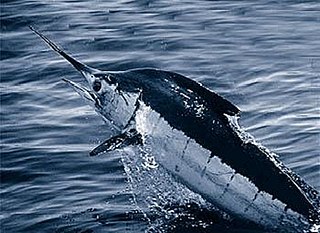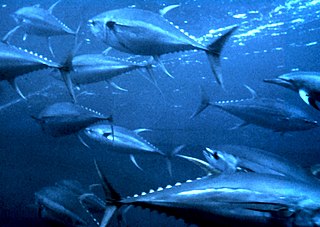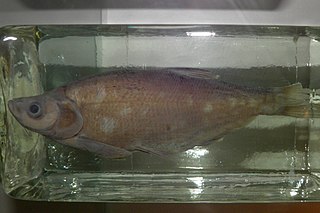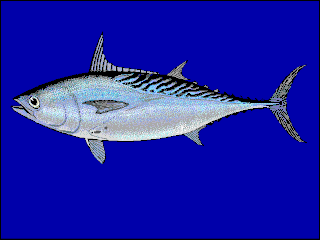
A tuna is a saltwater fish that belongs to the tribe Thunnini, a subgrouping of the Scombridae (mackerel) family. The Thunnini comprise 15 species across five genera, the sizes of which vary greatly, ranging from the bullet tuna up to the Atlantic bluefin tuna, which averages 2 m (6.6 ft) and is believed to live up to 50 years.

Mackerel is a common name applied to a number of different species of pelagic fish, mostly from the family Scombridae. They are found in both temperate and tropical seas, mostly living along the coast or offshore in the oceanic environment.

Herring are various species of forage fish, belonging to the order Clupeiformes.

The term carp is a generic common name for numerous species of freshwater fish from the family Cyprinidae, a very large clade of ray-finned fish mostly native to Eurasia. While carp are prized quarries and are valued as both food and ornamental fish in many parts of the Old World, they are considered trash fish and invasive pests in many parts of Africa, Australia and most of the United States.

Sardine and pilchard are common names for various species of small, oily forage fish in the herring suborder Clupeoidei. The term 'sardine' was first used in English during the early 15th century; a somewhat dubious etymology says it comes from the Italian island of Sardinia, around which sardines were once supposedly abundant.

Gadus is a genus of demersal fish in the family Gadidae, commonly known as cod, although there are additional cod species in other genera. The best known member of the genus is the Atlantic cod.

Sprat is the common name applied to a group of forage fish belonging to the genus Sprattus in the family Clupeidae. The term also is applied to a number of other small sprat-like forage fish. Like most forage fishes, sprats are highly active, small, oily fish. They travel in large schools with other fish and swim continuously throughout the day.

Indo-Pacific king mackerel, also known as the spotted seer fish or spotted Spanish mackerel, is a sea fish among the mackerel variety of fishes. It is found in around the Indian Ocean and adjoining seas. It is a popular game fish, growing up to 45 kg (99 lb), and is a strong fighter that has on occasion been seen to leap out of the water when hooked.

The billfish are a group (Xiphioidea) of saltwater predatory fish characterised by prominent pointed bills (rostra), and by their large size; some are longer than 4 m (13 ft). Extant billfish include sailfish and marlin, which make up the family Istiophoridae; and swordfish, sole member of the family Xiphiidae. They are often apex predators which feed on a wide variety of smaller fish, crustaceans and cephalopods. These two families are sometimes classified as belonging to the order Istiophoriformes, a group which originated around 71 million years ago in the Late Cretaceous, with the two families diverging around 15 million years ago in the Late Miocene. However, they are also classified as being closely related to the mackerels and tuna within the suborder Scombroidei of the order Perciformes. However, the 5th edition of the Fishes of the World does recognise the Istiophoriformes as a valid order, albeit including the Sphyraenidae, the barracudas.

The longnose catshark is a species of shark belonging to the family Pentanchidae, the deepwater catsharks. This shark is found in the eastern central Pacific from central and southern California and the Gulf of California, between latitudes 38° N and 23° N, at depths down to 1,890. Its length is up to 58 cm.

Thunnus is a genus of ocean-dwelling, ray-finned bony fish from the mackerel family, Scombridae. More specifically, Thunnus is one of five genera which make up the tribe Thunnini – a tribe that is collectively known as the tunas. Also called the true tunas or real tunas, Thunnus consists of eight species of tuna, divided into two subgenera.

An anchovy is a small, common forage fish of the family Engraulidae. Most species are found in marine waters, but several will enter brackish water, and some in South America are restricted to fresh water.

Anabarilius macrolepis is an extinct species of freshwater ray-finned fish belonging to the family Xenocyprididae, the East Asian minnows or sharpbellies. This species was endemic to Yilong Lake in Yunnan, China. It is believed that it became extinct when Yilong Lake dried up in 1981, as a result of water abstraction for agriculture. The species was not observed in 1983–84, and was declared extinct in 2011.
Chanodichthys flavipinnis is a species of freshwater ray-finned fish belonging to the family Xenocyprididae, the East Asian minnows or sharpbellies. This species is endemic to Vietnam.

The predatory carp, also known as the redfin culter or skygazer, is a species of ray-finned fish belonging to the family Xenocyprididae, the East Asian minnows or sharpbellies. This species ranges from the Amur River south to Taiwan and the Red River, as well as Lake Buir in Mongolia. It reaches 102 cm in length and 9 kg in weight.

Culter alburnus, the topmouth culter, is an East Asian species of freshwater ray-finned fish genus Culter, this belongs to the family Xenocyprididae.

Euthynnus is a genus of ray-finned bony fish in the family Scombridae, or mackerel family, and in the tribe Thunnini, more commonly known as the tunas.

Thunnus (Neothunnus) is a subgenus of ray-finned bony fishes in the Thunnini, or tuna, tribe. More specifically, Neothunnus is a subgenus of the genus Thunnus, also known as the "true tunas". Neothunnus is sometimes referred to as the yellowfin group, and comprises three species:

















